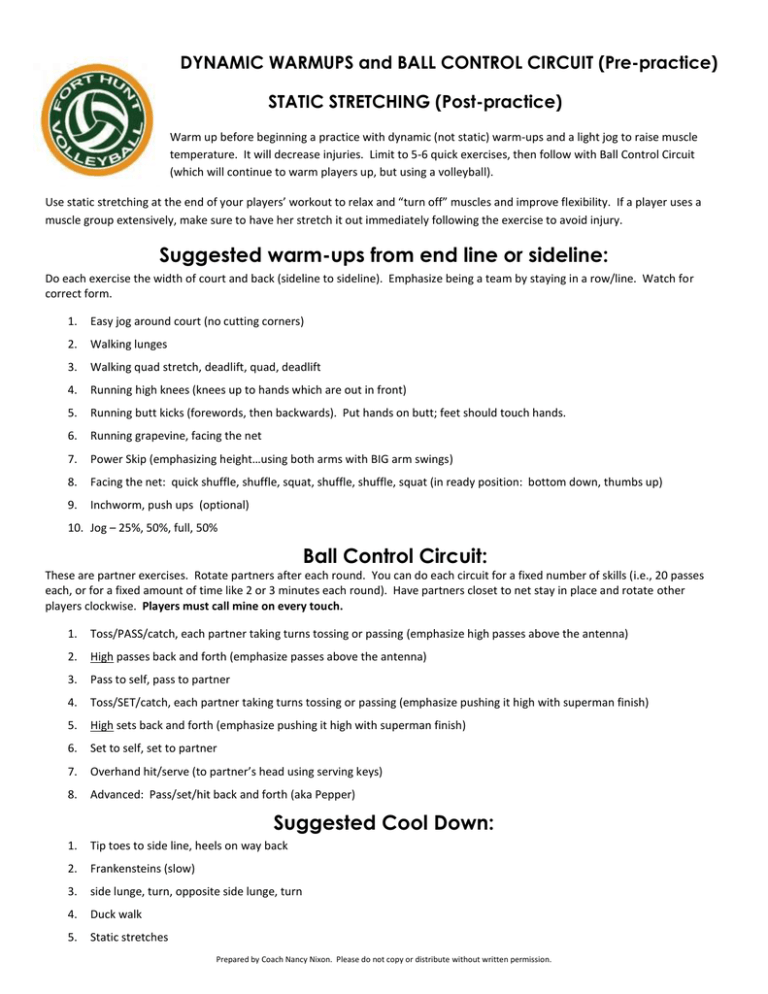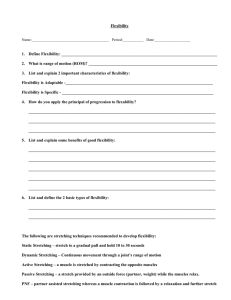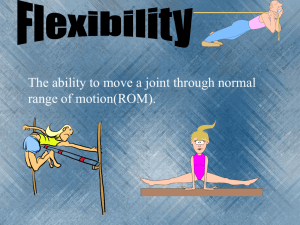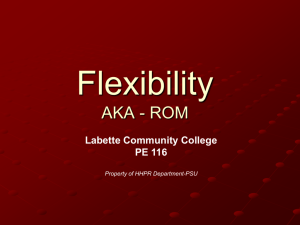DYNAMIC WARMUPS and BALL CONTROL CIRCUIT (Pre
advertisement

DYNAMIC WARMUPS and BALL CONTROL CIRCUIT (Pre-practice) STATIC STRETCHING (Post-practice) Warm up before beginning a practice with dynamic (not static) warm-ups and a light jog to raise muscle temperature. It will decrease injuries. Limit to 5-6 quick exercises, then follow with Ball Control Circuit (which will continue to warm players up, but using a volleyball). Use static stretching at the end of your players’ workout to relax and “turn off” muscles and improve flexibility. If a player uses a muscle group extensively, make sure to have her stretch it out immediately following the exercise to avoid injury. Suggested warm-ups from end line or sideline: Do each exercise the width of court and back (sideline to sideline). Emphasize being a team by staying in a row/line. Watch for correct form. 1. Easy jog around court (no cutting corners) 2. Walking lunges 3. Walking quad stretch, deadlift, quad, deadlift 4. Running high knees (knees up to hands which are out in front) 5. Running butt kicks (forewords, then backwards). Put hands on butt; feet should touch hands. 6. Running grapevine, facing the net 7. Power Skip (emphasizing height…using both arms with BIG arm swings) 8. Facing the net: quick shuffle, shuffle, squat, shuffle, shuffle, squat (in ready position: bottom down, thumbs up) 9. Inchworm, push ups (optional) 10. Jog – 25%, 50%, full, 50% Ball Control Circuit: These are partner exercises. Rotate partners after each round. You can do each circuit for a fixed number of skills (i.e., 20 passes each, or for a fixed amount of time like 2 or 3 minutes each round). Have partners closet to net stay in place and rotate other players clockwise. Players must call mine on every touch. 1. Toss/PASS/catch, each partner taking turns tossing or passing (emphasize high passes above the antenna) 2. High passes back and forth (emphasize passes above the antenna) 3. Pass to self, pass to partner 4. Toss/SET/catch, each partner taking turns tossing or passing (emphasize pushing it high with superman finish) 5. High sets back and forth (emphasize pushing it high with superman finish) 6. Set to self, set to partner 7. Overhand hit/serve (to partner’s head using serving keys) 8. Advanced: Pass/set/hit back and forth (aka Pepper) Suggested Cool Down: 1. Tip toes to side line, heels on way back 2. Frankensteins (slow) 3. side lunge, turn, opposite side lunge, turn 4. Duck walk 5. Static stretches Prepared by Coach Nancy Nixon. Please do not copy or distribute without written permission. DYNAMIC STRETCHING (Reproduced from Strength-and-Power-for-Volleyball.com) Dynamic Flexibility Training for Volleyball Volleyball teams often use dynamic flexibility exercises as a sport specific warm up for volleyball tournament matches. Dynamic flexibility exercises improve the long-term mobility and flexibility of your muscles. Dynamic flexibility work is necessary for teaching your body to move more safely, efficiently, and powerfully. Static volleyball stretching basically relaxes and turns off your muscles and is best at the end of a workout. By performing a dynamic stretching routine, you are going to wake up your muscles, activating them while you are moving. Dynamic Flexibility Exercises • Inchworm - Inchworms are great whole-body dynamic stretch exercises for volleyball. ◦ Purpose: To build stability and mobility at the shoulders while lengthening your hamstrings, calves, and low back muscles. ◦ Starting Position: Stand with your legs straight and your hands on the floor. ◦ Action: While keeping your abs braced and your legs straight, walk your hands out. While still keeping your legs straight, walk your feet taking small steps back up to your hands. ◦ Coaching cues: When taking steps, you shouldn’t be using your quads or hips. Use your ankles to take small steps back up to your hands. Prepared by Coach Nancy Nixon. Please do not copy or distribute without written permission. Forward Lunge Walks - Lunges are one of the best dynamic exercises to use in warm up. Volleyball players that aren’t familiar with this movement will likely experience an unfamiliar soreness. Lunges work the long adductor muscles, the muscles that run down the inside part of the thigh. ◦ Purpose: To stretch the front side of the hips while warming up all the leg hip extensors. ◦ Starting Position: Stand up straight with your hands at your sides. ◦ Action: Take a large step forward and bring your back knee to about 3 inches off the ground. Push through the heel of the back foot to bring your back foot up even with your front foot. Repeat the lunge with the opposite foot. ◦ Coaching cues: Keep your torso vertical and abs braced throughout the movement. Your step should be just big enough to bring your front knee above or slightly in front of your front ankle. Straight-leg Deadlift Walk - This is a great dynamic hamstring stretch. This flexibility exercise is very much like the one-arm one-leg deadlift whole-body exercise. ◦ Purpose: To improve hamstring flexibility and balance along with dynamic stabilization at the hips and core. ◦ Starting Position: Stand with arms straight out to your sides, thumbs pointing up while balancing on one foot. ◦ Action: Bend forward at the waist and lift your back foot up keeping the leg straight while maintaining good posture. The front leg should be slightly bent to help with balance. Bring your upper body back up and leg down at the same time. ◦ Coaching cues: Keep your shoulders back and down and abs braced. Your shoulders and heels should move at the same time, keeping a straight line from shoulders to heels. The range of motion will be limited by the flexibility of your hamstrings. Only go so far as you can with good technique. Prepared by Coach Nancy Nixon. Please do not copy or distribute without written permission. Walking Quad Stretch - Dynamically stretching the quads and hip flexors. ◦ Purpose: To dynamically stretch the quadriceps and hip flexors while also training balance. ◦ Starting Position: Stand up straight. ◦ Action: While bracing your core, grab your foot with the same side hand. Pull your heel up to your buttocks, stretching your quads. Bring the foot back to the ground and perform the stretch on the other side. ◦ Coaching cues: Remember, this isn’t a static quad stretch. The purpose is to stretch dynamically, so you shouldn’t be holding the stretch for a long time. This exercise can be done standing in place or while you’re slowly walking. Lateral Lunge - You can place your arms together out in front of you like you are going to make a volleyball pass when performing this exercise. ◦ ◦ ◦ ◦ Purpose: To dynamically stretch the muscles of your groin and hips. Starting Position: Stand with feet shoulder width apart. Action: Step to the right, keeping your toes pointed straight ahead and your feet flat on the ground. Squat back and down towards your lead leg. Keep your back leg straight and your weight over the lead legs heel. Squat as low as comfortable, hold for 2 seconds and return to the starting position. Coaching cues: Keep your body and feet facing ahead. Your knee should end inline with your foot when lunging. Try to keep your lead knee above your lead ankle or mid-foot, NOT out in front of your toes when lunging to the side. Shoulder Warmups – Shoulder rolls Prepared by Coach Nancy Nixon. Please do not copy or distribute without written permission. Static Flexibility Static Flexibility Training for Volleyball Flexibility training for volleyball should involve both dynamic and static stretching exercises. Flexibility is defined as a range of motion around a joint. Stretching is a means of increasing flexibility. A limited range of motion can compromise your volleyball playing skills or affect your ability to speed up or slow down when making plays on the court. Before practice or competition If static stretches are performed prior to a workout requiring explosive movements, the stretches may be counterproductive. Muscles are less responsive during the time immediately after static stretching. Static stretches confuse muscle and tendon reflexes which may throw off an athlete’s coordination. After practice or competition: Static stretching after a workout is the best time because your muscles are warmed up. The increased muscle temperature increases the elastic properties of the muscle and therefore allows for a greater stretch. Stretching can be used as part of a cool-down, which will help restore the muscle back to resting length, reduce soreness, and enhance recovery for the next volleyball workout. Only static stretch with reason Static stretching often feels good and can be relaxing, but static stretching isn’t always necessary. Only static stretch with a purpose. If you already have adequate flexibility, you are probably wasting your time. In fact, overly lengthened muscles can lead to problems such as muscular imbalances, thrown off muscular firing patterns, and possibly injury. An increase in flexibility may come at the expense of giving up stability or explosive power necessary for your volleyball performance. A flexibility deficiency rarely occurs in isolation. Lack of flexibility is usually related to a deficiency in strength and sometimes posture. Tight athletes have been known to significantly improve their flexibility just by participating in a balanced volleyball training program. Static Flexibility Exercises Sitting Toe Touch ◦ Purpose: To improve flexibility of the hamstrings and low back muscles. ◦ Starting Position: Sit with your torso vertical and legs straight. ◦ Action: Lean forward and grab your toes with your hands. Slightly pull the toes toward your upper body. ◦ Coaching cues: If you can’t reach your toes, you can use a rope to assist the stretch. Prepared by Coach Nancy Nixon. Please do not copy or distribute without written permission. Side Quadriceps Stretch ◦ Purpose: To stretch the quadriceps and hip flexors. ◦ Starting Position: Lie on your side with your legs straight. ◦ Action: Grab the ankle of your top leg, flex your knee and pull your heel slowly towards your buttocks. Semi-straddle ◦ Purpose: To stretch the hamstrings and lower back muscles. ◦ Starting Position: Sit with your torso vertical and legs straight. ◦ Action: Place the sole of one foot on the inner side of the other leg. The outer side of the foot should be resting on the ground. Lean forward and grab your toes of the straight leg with your hands. Slightly pull the toes toward your upper body. ◦ Coaching cues: If you can’t reach your toes, you can use a rope to assist the stretch. Straddle ◦ Purpose: To stretch your hamstrings, low back muscles, and the muscles on the inside part of your thighs. ◦ Starting Position: Sit with your legs straight and spread far apart. ◦ Action: With both hands, grab the toes of one foot. Pull your chest toward your toes. Return to the start position and repeat to the other side Butterfly ◦ Purpose: To stretch the muscles on the inside part of your thighs. ◦ Starting Position: Sit with your torso vertical. Bend your knees and bring the soles of your feet together. Pull your feet toward your body. Place your hands on your feet and elbows on your legs. ◦ Action: Pull your torso forward as you push down on your knees with your elbows. Straight Arms Behind Back ◦ Purpose: To stretch the chest and the front side of the arms. ◦ Starting Position: Stand up and place both your arms behind your back interlocking your fingers. ◦ Action: Extend your elbows fully. Slowly raise your arms, keeping your elbows straight. Behind-Neck Stretch ◦ Purpose: To stretch your triceps and back muscles. ◦ Starting Position: Raise your arm up and place your hand behind your shoulder while flexing your elbow. ◦ Action: Grab your elbow with your other hand and pull your elbow back behind your head. Cross Arm in Front of Chest ◦ Purpose: To stretch shoulder and back muscles. ◦ Starting Position: Grab your arm just above your elbow. ◦ Action: Pull your arm across your chest. Prepared by Coach Nancy Nixon. Please do not copy or distribute without written permission. • Arms Straight Up Above Head ◦ Purpose: To stretch your lats (back muscles). ◦ Starting Position: Stand with fingers interlocked and palms facing out. ◦ Action: Slowly straighten arms above head with palms facing up. Side Bend With Straight Arms ◦ Purpose: To stretch your obliques (side ab muscles), back muscles, and the serratus anterior (a shoulder muscle near your scapulae and ribs). ◦ Starting Position: Stand with fingers interlocked and palms facing out. Slowly straighten arms above head with palms facing up. ◦ Action: While keeping your arms straight, lean to the side. Flexibility training should be modified to meet the needs of each volleyball player. Prepared by Coach Nancy Nixon. Please do not copy or distribute without written permission.





